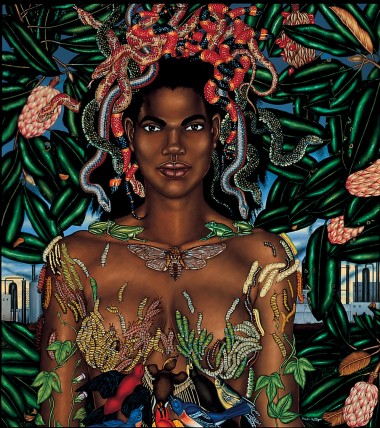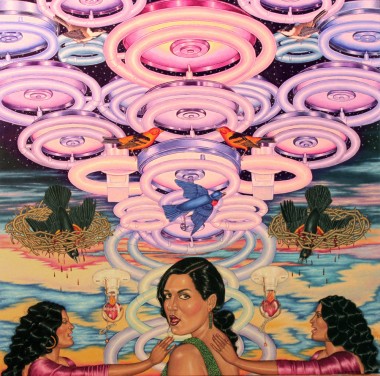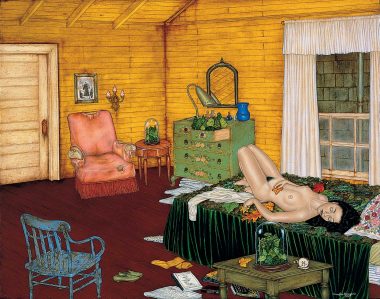
Douglas Bourgeois: St Anthony Appears to Tony, 1989. Oil on panel.
BY TERRINGTON CALAS
DOUGLAS BOURGEOIS
Contemporary Ans Center
New Orleans, LA
DOUGLAS BOURGEOIS’S ART feels disarmingly intimate. Beyond the rapt technique and startling syntax, what engages your notice ultimately is the circumscribed universe he creates – and further, the abiding spiritual tone of that universe. His paintings suggest some otherworldly realm – usually a lyricized south Louisiana – that exists only in reverie. Or, in a singular Eden. This is a deeply personal realm, and a perplexing one. And it is suffused with an intense religiosity. What you see are Bourgeois’s recurring subjects – Pop music luminaries and humbler, ordinary people – all rendered as sacred presences, sometimes as deities. They appear, trance-like, in spaces that seem filtered through a magical lens. Everything is somehow rarefied. Everything – even the grimmest, debris-strewn interior – has a certain transcendence. These pictures constitute a kind of sanctified dreamscape.
The Pop star images – apparently genuine homages – are easily Bourgeois’s most mystical. They have the air of a private Cythera, replete with shadowless idylls and sweet enigmas. In two recent pieces, Womack and Del Rey and Double Holy Spirit Coco, he transports you to a place of irrational splendor. Lana Del Rey is shown performing on the moon, looking fairy-tale beautiful, as she always does; Womack sings “That’s Where It’s At” (one would hope); and Coco O is graced with a canopy of fluorescent halos – in a composition that is sheer chromatic bliss.
Bourgeois has worked this sort of pictorial magic for many years. It has become something of a symbolic public service. In the face of snarling reality, we all need paradises, however fictive. These painted reveries fit the bill. Their theatricality alerts the eye, almost overwhelms the eye. But Bourgeois tempers it with a rich and strange poetry. You think of the poetic abstruseness one sees in Giorgione or, more pointedly, in Watteau. These works are theatre, yet nuanced and enhancing.

Douglas Bourgeois: Woman from St Gabriel, 1991. Oil on panel.
But Bourgeois’s depictions of performers tend to overshadow another, more complex, series of reveries. I mean the somber-mystical paintings, mostly genre scenes, that seem to hover over everything he does. They are, to be sure, equally magical, equally sanctified, but more personal – and tinctured with psychic truth. Certain pieces stagger you with their grave undertone. You sense a muted emotional charge – a pensiveness, indeed a yearning.
This impression is notably conveyed in his renderings of the solitary figure. Occasionally, he presents the figure transfixed, almost hypnotic. This image, arguably, signals the keynote of Bourgeois’s sustained reverie. In St. Anthony Appears to Tony, for example, it becomes clear that his reverie is hardly a mere romantic chimera – hardly the picturesque fantasy one might suspect. It seems, rather, an emotional sanctuary. Or at least, the hope of one. At first glance, the figure evokes the sentinel quality of a Piero fresco – with something of Piero’s coolness, too. But the total scene has an exigent temper. Tony stands motionless in his pattern-flung room, gripped by the sacred apparition. His aspect reads like a frozen violence of subjectivity. You see Tony confronting Tony in a “mirror” of disclosure – or perhaps of scrutiny, or of self-inquiry. It is a moment of inward dilemma. This image declares, with shattering concision, the dire reality of solitude.

Douglas Bourgeois: Double Holy Spirit Coco, 2013. Oil on board.
The evocative intensity in St Anthony – as well as in other pieces, such as the exquisite Dreaming of Home – is partly due to Bourgeois’s etiquette of feeling. He is expressive without resorting to expressionist tactics. There is no question that profound emotion sustains much of what be docs. And yet, the pictures are free of rhetoric and free of easy sentiment. His figures, moreover, almost invariably exhibit a vague dispassion. (This is especially true of the musical celebrities whose faces are glibly stage-ready.) Bourgeois’s tack is patently reserved – emotion via utter discretion. It amounts to a unique harmony of composition and color. He knows how to manipulate space, and how to wrest implied disquiet from it. Chiefly, he focuses on the dramatic potency of diagonals and negative spaces. His color sense is a question of temperature opposites, but not the obvious ones; only the near-complements. Not orange versus blue, but khaki-tan versus turquoise. Again, the discreet choice. The result of this maneuvering is a calm lyricism countered by the subtlest of visual tensions. You see this in Dreaming of Home. It is a serene image, but also it seethes.
As an explicit theme, this notion of emotional anxiety – particularly as linked to solitude – appears sporadically in Bourgeois’s oeuvre. But it is key to grasping the core of his meaning. It spreads a melancholy veil over everything he does. This is because there is an unmistakable drift of auto-reflection in his work and, perhaps, he acknowledges an artist’s ineluctable apartness. At the same time, he seems aware of his role as consummate watcher of the individual, of other individuals. You felt this solidary viewer, somehow, as if for the first time, in Bourgeois’s abbreviated survey recently at the Contemporary Arts Center.
HIS PAINTINGS ARE meticulous and rich and strange, less artworks than spectacles. Taken together, they suggest some relishable hallucination that Bourgeois fashions wittingly, then induces us to share. In most instances, he transforms images into a singular brand of exotica. And, as such, they feel alien and implausible, yet, at the same time, patently seductive. They pull us out of ourselves and into an enchanted land that is both familiar and not. What we encounter there, chiefly, are Bourgeois’ people – some famous personalities, but also a variety of graceless denizens surprisingly exalted. He labors over them, burnishes them to the point of lustrous ”sainthood.” Dwellings, too, are transformed. In this furbished world, even squalid rooms seem haven-like. The consequence is an environment as elusive, as radiant, and, in its way, as utopian as Matisse’s luxe. Painting as salvation.
lt is no surprise that we should be drawn to these pictures. In part, Bourgeois’s technical rigor accounts for that. He uses a painstaking oil technique, almost Netherlandish in its delicacy and precision. The fine detail and highly glazed surfaces are irresistible. Few painters today would, or could, endure the tedium of the process. And that process deepens the exotic tenor of his work. The more he refines a composition, grafting keenly observed elements to the whole, the stranger and more beguiling the image becomes.

Douglas Bourgeois: Dreaming of Home, 1993. Oil on panel.
But this technical appeal is only the beginning. We are also drawn, equally I think, to Bourgeois’ idiosyncratic vision, his recurring mysticism. It is not very unlike the way we take to Max Ernst (of the early collages), or Rene Magritte, or Joseph Cornell. Cornell especially. The conspicuously different idioms notwithstanding, there is in Bourgeois’ art a parallel to Cornell’s wistful musing. In both cases, the most memorable pieces can be seen as tone-poems of yearning, as if the artists were detached from their subject, but mesmerized by it. Cornell was certainly detached from his; largely, it was a chimerical perception of the Europe he never saw. Much of Bourgeois’ subject is, in fact, close to him – the place where he grew up and where be lives today. Still, a certain remoteness obtains in his work. It suggests a rapt observer living within a distinct and unusual culture while finding himself somehow isolated, cherishing that culture though not exactly fitting in. He elects to see it as the poetical place it might be and, through art, restructures it until it conforms.
The lyrical yearning in his art recalls a significant moment in the history of modernism – the appearance, over a hundred years ago, of a visionary prose-poem by Charles Baudelaire. It was the poet’s Symbolist anthem, and perhaps, the anthem of all quintessentially French art from that point forward – and, indeed, with forebears in Poussin and Claude. Baudelaire spoke of a peculiar “fever that grips us…a nostalgia for a unique land, a land superior to others, as art is superior to Nature, where Nature is reshaped by reverie, where it is corrected, beautified, remolded.”
“Reshaped by reverie.” These words obviously constitute a textbook antecedent of a true Symbolist like Redon or a spiritual hedonist like Matisse or a quasi-surrealist Francophile like Cornell. But, it would seem, the idea can also reveal much about the achievement of an artist as resolutely American as Bourgeois.
To be sure, his link to this essentially French symbolist/surrealist ethos is not always apparent; certain paintings fairly refute it. But with each new body of work, there is more evidence that he falls securely within that hybrid tradition. The way he recasts – or , in effect, canonizes – his human subjects is part of it. It situates them in that moody Baudelairean state and separates them from the prosaic, or perhaps joyless, lives they actually live.
At times, he presents the figure as something emblematic, very like a compelling sacred icon. In the CAC show. a good example of this is the now-classic Woman from St Gabriel (1991), a compressed and elaborate salute to certain “exotic” hallmarks of southern Louisiana. It features a caramel-colored Medusa crowned with indigenous snakes, gracefully covered in a dress-pattern of birds, frogs, caterpillars, and vines. The background is almost entirely magnolia leaves, impossibly glossy, completing a virtual mosaic of jewel colors. The only relief from this beauty surfeit is a small slip of landscape behind the woman’s shoulders. The sad grey props of industrial exploration sit there, acting as a meager compositional prop in this complex painting and, simultaneously, holding the line as an encroaching force within our state’s natural beauty.
Woman from St Gabriel is one of Bourgeois’ most enduring works. It encompasses his inveterate apotheosis of the human figure, as well as a prudent political note. That apotheosis is widely familiar in his depictions of Pop musicians; their stage-ready grins and luminous costumes are easy correlatives to the magical aura he confers. But in this instance, with a humbler subject, the apotheosis attains a further objective. Bourgeois seems to equate the ennobled woman with the land, both of them exquisitely strange and both of them imperilled.
IN ANOTHER OF Bourgeois’s recurring subjects, the thrust seems profoundly personal. Still, the Baudelairean moodiness abides. At moments, it becomes even more of an issue. As mentioned above, these are the paintings of ordinary young men and women, usually isolated in grungy bedrooms and kitchens. They have far less polish than his musicians and symbolic figures. In fact, they often seem debased – somewhat consistent with their grim environments. But they, too, in a wholly different way, are exalted. Or, at least, their situation is. In these interiors, Bourgeois makes no transformation from real to glamorous. Rather, the transformation is more like the collision of two distinct states – the wretched and the mystical. Despite the clutter of each interior, exacerbated by Bourgeois’ insouciant pictorial structure, the space and the event are utterly still, hushed. He creates a devotional milieu and we catch it in the middle of some urgent ceremony. A lone figure, in suspended reverie, seems to undergo a religious or other experience.
An aura of piety prevails. This, despite some telling, intensely observed details: an overflowing sink, overflowing garbage, a bedroom strewn with used Styrofoam cups and spilled potato chips, cigarettes, a motionless young man with tattooed arms, a girlie magazine. To this, add a divine king – an infant one, and swarthy, too – floating by a kitchen window. The result is something bizarrely ecclesiastical, something like Louisiana Catholicism.
This is where the term tone-poem seems most fitting in discussing Bourgeois’ work. The poetry is the palpable spiritual quality that he accords these rooms. Each space is like a highly unconventional shrine prepared for each figure, where he or she might find redemption. This feeling may come, in part, from the lighting – frontal and static like stage lighting, but without cast shadows. And there is also Bourgeois’s distinctive modelling. His approach is, at once, rigorous and diffident – so diffident, in fact, that deeper tones scarcely exist. There is no conventional chiaroscuro. This calls to mind the subdued shading in Manet: a system of light tones and half-tones and no more. In Bourgeois, the measured technique imparts a marked clarity of form, and a certain abruptness. Objects seem galvanized. The consequence is a frisson that arrests everything, most notably the figure. In these scenes, the figure looks to be in a spell – some religious state that evokes any number of quattrocento Annunciations.
On occasion, as in St. Anthony Appears to Tony, there are holy apparitions, miracles. But these are hardly necessary. The eerie spirituality is already there. A saint at the doorway, with piously joined hands, is almost a superfluous intrusion into these wonderful home-shrines.
It must be added hastily that Bourgeois tempers the peculiarity of such interiors. They are not only mystical. They are, as it were, psychologically balanced. He leads us back and forth, from the religious to the secularly mundane. This comes from his unsparing eye. He sees, and he shows us, everything. But in spite of all the endless detail, nothing seems trivial. This is a question of intensity. Every scrap on the floor, every box on a shelf rings with it. He underscores so many unlikely details and does so with such labored scrutiny that you are persuaded to see them as charged elements, not of a conventional genre scene, but of some “real life” episode – perhaps on stage, or in film. In the apparent squalor, you can sense a cinéma vérité rawness. And a cinema-like transformation where untidy physical realities seem oddly alluring.
This applies also to the young inhabitants. Bourgeois confers on them a distinct presence beyond the unlovely setting and beyond the religiosity. There is a greasy sexiness about them. These men and women are hardly elegant, but they have dark, cinematic looks. The women, as in Dreaming of Home (1993) and The Traveller (not in this exhibition), are sometimes reclining nudes, with the bold sensuality of an odalisque. The men actually evoke Bourgeois’ earlier portrayals of teen idols such as Sal Minco and Elvis.
These are scruffy stars, but stars nonetheless. They enjoin attention. And they amplify one of Bourgeois’s continuing undercurrents: the profound isolation of an artist. These magical figure-in-room compositions are as close as one can get to spiritual autobiography without declining into conspicuous narrative. A great deal is implied here. There is the truth of detachment in an artist’s effort to confront something as powerful as Catholicism. There is the sad truth of an artist’s uneasy fit in everyday society. And further, there are one man’s private obsessions – dazzling music personalities, a Lush Louisiana paradise – laid before us because, as an artist, he has no alternative.
The artist, apart from the rest, often must live normal life vicariously. Sometimes, he/she must fabricate the deliciousness of that lite. That is what happens in Bourgeois’s seductive paintings of musicians. They are conduits devised for transcending moments of mean reality. But the artist has a weightier task. More than anyone else, he/she is equipped to confront and to assert life’s actual meaning – and to present it. That meaning, at core, is what we see in Bourgeois’s lonely and poignant interiors.
This complex body of work is the utterance of an artist who wields reverie to penetrate that meaning. To penetrate everything from flights of fancy to unavoidable truth. Time and again, his effort is persuasive.
